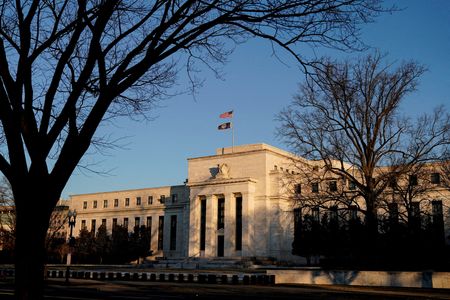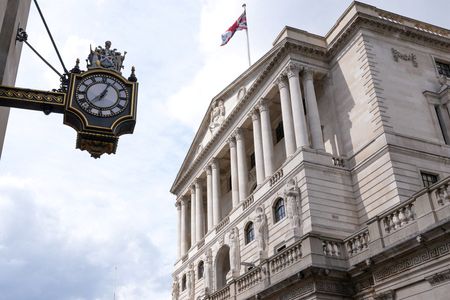By Mike Dolan
LONDON (Reuters) – For all intents and purposes, financial markets think the brutal central bank tightening cycle is done.
That may seem like a leap of faith after 36 hours in which three major central banks lifted their main policy interest rates yet again – and warned of more to come.
And yet policymakers and markets can probably reconcile those apparently contradictory views, if what you really care about it is where policy interest rates are at the end of the year rather than dwelling on the ‘ifs’ and ‘buts’ about what temporary peak they may or may not hit in the interim.
U.S. federal funds rate futures now see the policy rate at about 4.39% at the end of 2023, just over a quarter of a percentage point below the mid-point of the new 4.50%-4.75% range the Federal Reserve set on Wednesday after it hiked rates by 25 basis points. Two-year Treasury yields dropped to within a whisker of the 4.00% level, the lowest in four months.
Even though Fed Chair Jerome Powell, speaking in a news conference after the end of the policy meeting on Wednesday, talked loosely of a “couple of hikes” more in the pipeline, he claimed he was “not particularly concerned” with that full-year market view.
There will much huff and puff and second-guessing over what happens in the meantime. Markets are priced for just one more quarter-percentage-point hike. The Fed still seems loathe to guide too assiduously and prefers to keep its options open.
But stock and bond investors certainly see the horizon clearing rapidly. While a return of FOMO – fear of missing out – is inevitably part of the dash to catch ‘peak rates’, there’s every reason to think disinflation is well underway.
Powell was unequivocal about that much at least. “We can now say for the first time that the disinflationary process has started,” he told reporters.
Goosed by a positive twist to the earnings season from Meta, the Nasdaq has climbed 5% in just two sessions, its best two-day spurt since November and following its best January since 2001. The S&P 500 index surged too and – significantly – Wall Street’s main gauge of implied volatility sank to its lowest level in more than a year.
Graphic: The race to raise rates The race to raise rates https://www.reuters.com/graphics/CANADA-CENBANK/dwvkdeaqopm/chart.png
Graphic: Fed rate cuts: not so fast? https://www.reuters.com/graphics/USA-FED/RATECUTS/klpygdgzqpg/chart.png
Graphic: BoE’s fight against inflation https://www.reuters.com/graphics/BRITAIN-BOE/klvygddnovg/chart_eikon.jpg
CORNER TURNED
A similar rates picture unfolded in Britain after the Bank of England executed its 10th straight interest rate rise on Thursday, bringing its main policy rate up half a percentage point to 4.0%.
Even though money markets see one more quarter-percentage-point hike in the works – pricing for the end of the year shows the Bank Rate now a fraction lower than it is now, essentially signalling that the BoE is either done already or that it will have reversed any additional mid-year move by then.
Like Powell, BoE Governor Andrew Bailey reckoned inflation had “turned the corner” – even though he said “it’s too soon to declare victory just yet.”
Bailey may be right, but it’s not hard to see why investors are now homing in on the limits of any tightening from here.
Judging by this week’s latest International Monetary Fund forecasts at least, Britain is the weakest of the G7 economies and the only one set to contract this year – with myriad peculiar domestic problems from Brexit to tax rises and energy shocks as well as serial labour strikes.
Elsewhere, the Bank of Canada already signalled last month that it’s pausing its rate rises. And the Bank of Japan insists it’s still in easing mode.
The European Central Bank’s decision on Thursday to hike its policy rate further by half a percentage point to 2.5% and signal at least one more increase of that size in March puts it in a different if slightly lagged place. But even there, money markets barely see the rate below 3% in a year’s time.
Jason Draho, head of asset allocation Americas at UBS Global Wealth Management, reckons “there’s little investment value in over-analyzing a central banker’s mindset.”
And in some ways, that’s fuelling a rush to second-guess the ultimate outcome – even if it ends up taking value out of asset prices quickly and potentially seeding more volatility longer-term.
“Far from putting an end to market momentum … yesterday’s FOMC (Federal Open Market Committee) outcome is more likely to exacerbate it for the time being,” Draho wrote. “That will heighten investor FOMO at the same time that the risk-reward trade-off for many assets becomes less attractive.”
And if the central banks themselves seemed inclined to allow markets to do their own thing this time around, then it was left to the IMF to act as head teacher.
“Central banks should communicate the likely need to keep interest rates higher for longer until there is evidence that inflation – including wages and prices of services – has sustainably returned to the target,” the head of the IMF’s monetary and capital markets department, Tobias Adrian, and his two deputies wrote in a blog post.
“Loosening prematurely could risk a sharp resurgence in inflation once activity rebounds, leaving countries susceptible to further shocks which could de-anchor inflation expectations,” they added.
If that plays out, markets may still justify pricing the end of tightening. When they begin easing again may be a harder call.
The opinions expressed here are those of the author, a columnist for Reuters.
Graphic: ECB hikes again and signals more to come https://www.reuters.com/graphics/GLOBAL-CENTRALBANKS/dwpkdeejmvm/chart.png
Graphic: Developed markets interest rates https://www.reuters.com/graphics/GLOBAL-MARKETS/RATES/egvbyaawqpq/chart.png
Graphic: Is the selloff in tech stocks over? https://www.reuters.com/graphics/TECH-STOCKS/TECH-STOCKS/egpbyaaeqvq/graphic.jpg
(by Mike Dolan, Twitter: @reutersMikeD; Editing by Paul Simao)



